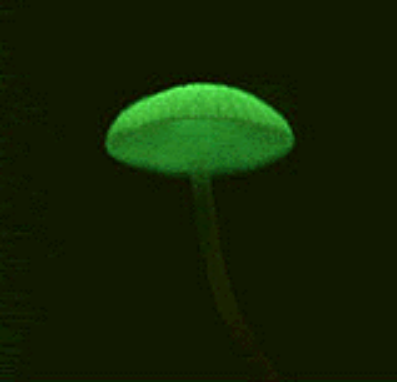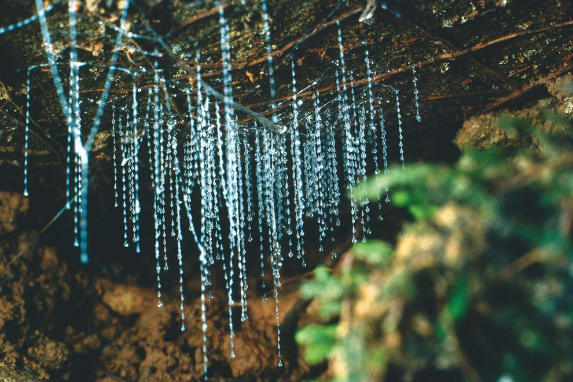Both glow worms and fireflies are not worms and flies as their names suggest. You can read all about these insects here, as well as bioluminescence and how it used by insects and other life forms.
Glow worms
The glow worm isn't a worm at all, but the larvae or maggot of a mosquito-like fly. Only three glow worms have been described in Australia. Arachnocampa flava is a species endemic to Queensland. Glow worms can be found in shady, protected places with high humidity. You might find them in cuttings, creek banks, rock faces and the roots of fallen trees.
Glow worms build ‘snares’ made of silk fibres coated with mucous. The snares consist of tubes in which the glow worms are suspended, as well as long, hanging filaments coated in sticky beads of mucous. The glow worms emit a pale light which attracts insects toward the sticky threads of their snare. The blue/green light is a product of a chemical reaction between luciferin (a waste product), the enzyme luciferase, adenosine triphosphate (ATP - the energy molecule) and oxygen. The snare usually catches small bugs such as midges, but insects as big as cockroaches can be entrapped.
Fireflies
In the early evening, flashing lights can often be seen cruising around in the forest. These are the little lanterns on the underside of the abdomen of a carnivorous beetle of the family lampyridae. These beetles have been misnamed fireflies. It is believed that the flashing light is used by males and females to attract each other. The light is created by an enzyme (luciferase) which reacts with other chemicals in the insect's body to produce light energy. The firefly regulates the emission of light by controlling the amount of air supplied to the cells. The regularity and intensity of the flashing may help fireflies identify males and females. Both the firefly larvae and wingless females can also be also known as glow worms. The larvae of the firefly has a flat, segmented body resembling a kind of serrated flatworm. This larvae has two little 'windows' at the back end of the body through which a pale green glow is seen. Why the larvae also glows is unknown.
Glowing in the dark - bioluminescence
The ability of plants, fungi or animals to glow is called bioluminescence. Things that glow in the dark can be extremely mysterious and fascinating. Glowing ghost and Halloween costumes are popular. Star stickers can keep shining on a bedroom ceiling after the night light is extinguished. People make practical use of glow in the dark clocks. Glowing in the dark is also employed by many of the so called ‘lower animals’ and invertebrates as part of their ecology.
Living things which are capable of creating their own light are called bioluminescent. Since William Beebe explored the darkness of the deep ocean, science has known that many deep sea marine species have glowing spots in strategic places or patterns on their bodies. Terrestrial species with similar abilities continue to be discovered. Many of these are small invertebrates and fungi, usually hidden from view in the dense rainforest vegetation, leaf litter or soil. Finding new species during the light of day is difficult enough. Finding a newly discovered species with abilities that can only be seen in the dark can be even more difficult.
In the Wet Tropics rainforests, there are a number of living things which produce their own light. These include fungi, fireflies, glow worms, and some large earthworms. It is likely that there are also snail species here which are bioluminescent since many such land snails have been found in Southeast Asia.
 How does a living thing create light?
How does a living thing create light?
Presented as simply as possible, bioluminescence occurs when the luciferase enzyme and the chemical luciferin react. A third element needs to be present for this reaction to take place which varies according to the type of animal or fungus. For example, adenosine triphosphate is required in fireflies and glow worms; calcium for jellyfish and peroxide for earthworms. Oxygen is also sometimes required. Whatever the exact reactants are for each animal or fungus, the end result is the release of energy in the form of light.
The chemical reaction described above and the resultant unstable by-product are often referred to by the experts as 'an excited state'. In some cases, this may be a clue as to why an animal might be bioluminescent but the situation is different for each type of animal that has the ability to glow. For fireflies, the ability to glow is useful for attracting mates. The glow worm has a better chance at a full dinner because it uses its pale green light to draw in a curious, unsuspecting meal.
Why would a living thing want or need to create light?
Living things use bioluminescence for a variety of reasons. Glow worms use their pale green lights to attract an unsuspecting meal to their ‘snares’, made of mucous-coated silk threads hanging from tubes in which the glow worms reside. Fireflies use the ability to glow for attracting mates.
No one knows why many species use bioluminescence. Why would fungi use light? What use is light to an earthworm living in the dark soil?
There are very few researchers in Australia involved in the study of this fascinating aspect of life in our living museum, but perhaps as more species are discovered with this strange ability, more answers for the existence of bioluminescence will come to light.
Many thanks to Professor Barrie Jamieson of the University of Queensland Zoology and Entomology Department for taking the time to provide his expert assistance and informative materials about bioluminescence.
